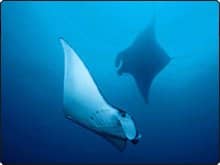In the course of researching manta ray aggregations in South East Asia, Dr Andrea Marshall world-leading manta ray expert, stumbled upon an oasis of bio-diversity when diving in Burma (Myanmar).
Andrea’s first impression of South Burma was one of awe; the stunning scenery of dozens of tiny limestone islands dotting the sea took her breath away. Burma has featured heavily in the news over the last few years due to its controversial govermnents, international embargoes and political prisoners, so it is hard to imagine that this war-torn country boasts such beautiful untouched seascapes.
 Andrea’s manta ray research programme has dramatically increased the amount of knowledge that exists about these majestic creatures. The purpose of her Burma visit was to have a closer look at the manta rays that aggregate seasonally in this region.
Andrea’s manta ray research programme has dramatically increased the amount of knowledge that exists about these majestic creatures. The purpose of her Burma visit was to have a closer look at the manta rays that aggregate seasonally in this region.
From late January to early May giant mantas are frequent visitors to the offshore islands along this coast, from Thailand’s Similan Islands, to the archipelagos of Burma further north. These islands – over 800 of them and their associated reef systems, are home to an incredibly rich biodiversity.
On the expedition, there were sightings of many interesting marine creatures at the various dive sites but it was the tiny limestone island of Black Rock that most made an impression on Andrea.
She says; “What I found exceeded every expectation I could have imagined. Forests of fans and soft coral in every colour. Beds of anemones that covered boulders as far as the eyes could see. Schools of low-lying glassfish so dense, that as they hugged the reef they gave off the illusion of a moving carpet. The reefs were alive with crustaceans and tropical fish of every variety and colour.
Cuttlefish provided extravagant light shows in surface waters, as their skin attempted to camouflage them against the canvas of the reef. Game fish from kingfish to barracuda darted in and out of my frame of vision. It was a visual symphony and my senses reeled. Then as if on cue, the mantas arrived out of the blue……Giant mantas filled the water column from the 10 metre mark until they faded into the darkness at 50 metres … Black Rock now stands as one of my top 10 best dive sites of all time.”
Andrea encountered at least 11 individual mantas at Black Rock which indicates this is an important aggregation site for them seasonally. She also successfully satellite-tagged 2 of the mantas on this expedition which will provide valuable data on their migratory habits.
Unfortunately, Burma’s waters have suffered over the years from destructive fishing methods and the results of this are clearly evident in a few areas. However, protective methods are now in place to try to stop over-fishing. What is needed is greater awareness of the ecological importance of these sites and this can be achieved through sustainable dive tourism as it generates revenue for the area and highlights the need for greater marine protection.
So why not go and see for yourself? By taking a Burma Liveaboard holiday you are helping the authorities to recognise the value of thriving numbers of fish and marine creatures in a healthy environment. Your holiday can have a positive impact on the protection of the dive sites, and at the same time it will be a truly memorable and exhilarating experience!
For more on Burma’s underwater world see here: Burma Dive Sites
To enquire about Burma Trips or for more information Contact Dive The World right away on +66 (0)94 582 7973 / (0)83 505 7794 or send us an email.